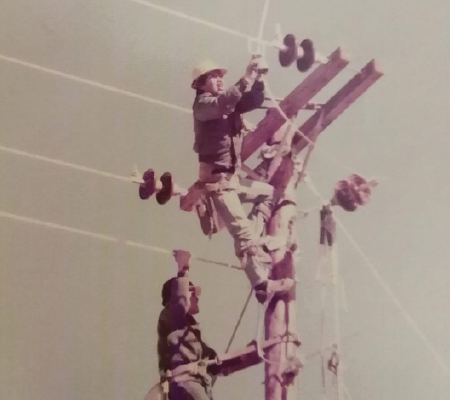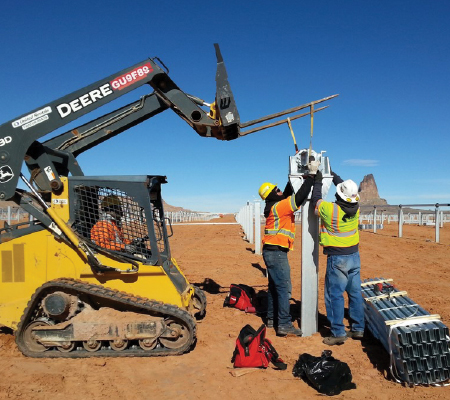By the 1920s, most people who lived in America’s towns and cities had electricity, but as late as 1932, only 10% of rural households had electric power, according to Smithsonian researchers. That began to change with the Rural Electrification Act of 1936.
However, while much of rural America became electrified in the ’30s and ’40s, the Navajo Nation was forgotten, said Walter W. Haase, general manager of the Navajo Tribal Utility Authority. To this day, the Nation has the majority of homes that do not have electricity within the United States.
Still largely in the dark at the end of the 1950s, the task of creating NTUA was given to Walter Wolf Jr., who served as legal counsel to the Navajo Nation leadership and, once established, to NTUA for about 60 years.
NTUA formally launched in 1959 as a water utility and quickly expanded to include electricity. This was shortly before the Glen Canyon Dam was built, before massive electric transmission lines were placed within Navajo land, when utility development in the Southwest was in growth mode. In a news release reflecting on Wolf’s legacy following his death in January this year, NTUA shared that he recalled about this beginning that, “Once we got started in the distribution business, we knew our work would be difficult and challenging. But we knew it had to be done.” In 1965, NTUA took over its first distribution line from the U.S. Bureau of Indian Affairs, and over the years, the utility gradually added distribution infrastructure where none had existed before.
Bringing in the light
Since 1959, NTUA has been hard at work electrifying homes and businesses across its service territory. On top of the challenges of starting a utility from scratch, NTUA also had the challenge of access.
The Navajo Nation is a vast territory, comprising 27,000 square miles — about the size of West Virginia — and spans parts of three states (Arizona, Utah, and New Mexico). Many Navajo homes are in isolated areas, miles from any paved road and difficult to reach. Within the Nation, 38% of people live below the U.S. poverty line, 32% of the Nation’s 55,000 homes lack electricity, 86% of homes do not have natural gas, and 38% lack a water source on the premises.
 It’s a tough place to be a utility. In the Nation, there can be 100 miles between one substation and the next, so system operators rely on capacitors to keep voltage up. NTUA serves its customers with 10,000 miles of conductor and 4.3 houses per line-mile.
It’s a tough place to be a utility. In the Nation, there can be 100 miles between one substation and the next, so system operators rely on capacitors to keep voltage up. NTUA serves its customers with 10,000 miles of conductor and 4.3 houses per line-mile.
Between 2008 and 2018, the first 10 years in which Haase led NTUA, the utility connected 5,213 homes to the electric grid, and NTUA contributed nearly $8 million of its own funds to achieve this. Still, the utility wanted to move faster and reduce the expense of each connection. In 2019, NTUA initiated Light Up Navajo, a pilot project organized by NTUA and the American Public Power Association, built off of the idea of mutual aid without a storm.
Through the initiative, 138 lineworkers from utilities coast to coast pitched in to help NTUA lay more than 50 miles of line and bring power to homes that often were not funded through grants or scheduled for service connection any time soon. Last year, Light Up Navajo connected 233 homes, 175 of which would not have been connected through NTUA’s usual process, and these residents might have waited at the very least 10 years to get electricity in their homes. After setting poles and connecting homes, the teams of NTUA lineworkers and visiting lineworkers stood inside humble residences, many of which belonged to elderly men or women — some of whom had waited a lifetime for power.
Light Up Navajo cuts the daunting cost of bringing power to remote homes in NTUA’s territory. The average cost to connect one family reaches $40,000, but this program pared that down to $8,000.
Electricity that most people in the U.S. take for granted brought grateful tears of joy to those fortunate enough to be part of the Light Up Navajo pilot project. Deenise Becenti, public affairs manager at NTUA, said it means families no longer need to travel many miles to get fresh food multiple times per week because now they can plug in a refrigerator. It also gives people a way to charge cell phones or read after dark.
One elder, a grandmother, was thrilled because electricity would allow her to make toast in her home for the very first time. Another young mother told Becenti that she joined her husband to work in Texas so she could help build their savings so that they could pay for a power line extension. She told Becenti, “We would come home one weekend out of the month. It was always hard to leave to head back to Texas. Now I can be with my kids. My husband still works in Texas, but I don’t have to leave them.”
Haase hopes the lineworkers from other utilities who volunteered for Light Up Navajo spread the word so the program can grow in coming years. After all, it’s not just water, power, gas and communications NTUA delivers. It’s what Becenti called “a life-changing difference.”
This year, the Light Up Navajo II project is targeting 300 families. Although the initiative was postponed due to COVID-19, Haase hopes to pull teams together and run the program again later in 2020.
Affordability matters
Electrifying homes fulfills one part of NTUA’s mission. Another is ensuring that how it operates supports a thriving community. In the Navajo Nation, annual per capita income averages $10,700 — nearly one-fifth of the mean per capita income in the U.S, which the Census Bureau estimates at $50,413.
“Our rates are less than what surrounding utilities charge,” Haase said. “They have to be because our people just can’t afford more. We don’t want them making difficult choices: Pay the utility or buy food.”
One way to keep rates down is to drive revenue, and the first initiative Haase launched to do this was deploying wireless communications. “We’ve been able to create products and services that the community desperately needed and that helped us keep our costs low,” he said.
Haase said one of his first priorities when he started 12 years ago was putting the utility’s financial house in order. He led the team to pay down bills, finish five years’ worth of financial audits, and bring the utility’s financial ratings up enough to qualify for loans from the U.S. Department of Agriculture’s Rural Utilities Service. With RUS funds, he was able to expand the utility’s services, revenue, and workforce.
Haase leveraged NTUA’s newly raised credit rating to apply for grants associated with the American Recovery and Reinvestment Act of 2009. In 2010, the utility earned $32 million in stimulus funding to build out a high‐speed internet highway that would deliver broadband and cell phone service throughout the Nation.
In three years, NTUA laid 550 miles of fiber optic cable and installed or upgraded 59 communications towers. That initial phase of the project gave enhanced internet access and cell phone service to more than 30,000 households as well as approximately 1,000 businesses and 1,100 community institutions within the Navajo Nation.
In this effort, NTUA partnered with Commnet, a leading provider of communications services in rural areas, and created NTUA Choice Wireless, a retail cell phone service provider. NTUA holds the majority share of ownership of this entity, making it the largest Native American-owned wireless communications company.
To date, NTUA has built and tested more than 800 miles of fiber optic backbone, erected 173 microwave links, 110 towers and 43 sites with 4G LTE technology. The wireless entity employs 84 people, and 98% of them are of Navajo descent. Some 20,000 people now enjoy affordable cell phone service through this endeavor.
The broadband infrastructure also allowed the utility to build a fully certified Tier 3 data center, the only such facility in the region. The data center hosts data belonging to NTUA, the Navajo Nation and corporate clients, giving the utility yet another way to add revenue and employees.
A bright future
Another venture that supports economic development within the Navajo Nation and keeps NTUA moving forward is solar power generation.
Today, renewables make up about 40% of the utility’s generating resource mix. In 2017, the utility went live with a 27.3-megawatt solar farm called the Kayenta Solar Project. It generates enough power for 18,000 homes.
“The Navajo people prefer power sources that are in better harmony with the earth,” said Haase.
 In addition to community preference, the solar projects provide dollars for and development into the community. NTUA gains revenue from selling the energy from the project and the carbon-emission offsets to Salt River Project, a public power utility that serves more than 2 million people in central Arizona.
In addition to community preference, the solar projects provide dollars for and development into the community. NTUA gains revenue from selling the energy from the project and the carbon-emission offsets to Salt River Project, a public power utility that serves more than 2 million people in central Arizona.
Construction of the project also brought money into the Nation. Kayenta produced 278 jobs, 85% of which were held by people of Navajo descent. That workforce earned $5.2 million over the course of the project and received more than 4,700 hours of specialized training related to solar plant construction.
NTUA leveraged that experience and broke ground on a second 27.3-MW project, called Kayenta II, a year later.
Construction taxes on the two projects generated $25.1 million for the Navajo Nation. Payroll equalled $9.5 million. Over the next 30 years, the two plants are expected to generate approximately $12.6 million in tax revenue to help the Nation prosper.
These projects also help Navajo people earn money on and off tribal lands. “We are trying to create a transitionary path where we build a project every year or so and keep the workforce working,” Haase said. “When people get hired to work on their first solar plant, they’re unskilled and work on the lowest-level jobs. When they come back the next year to build another project, they get a higher-level job.”
Haase added: “Once you learn how to do the wiring and you’re part of the electrical team building the power plant, you’re a step away from becoming an electrician. Our workforce is construction-oriented to begin with. They travel all over the United States building things. This fits right in.”
Currently, NTUA is working on a 66-MW solar facility that will sell almost all of its capacity to other power providers. Returns from this project will generate revenues to help keep NTUA’s rates low and pay to electrify more homes across the Navajo Nation.
“It brings personal satisfaction to see what we started has grown into what it is today. … Every power line that we build is an achievement, and every family that we connect is a success story,” Wolf said in 2016. “There are still so many families without electricity. What we started in 1959 hasn’t changed today — our important work is far from over.”

